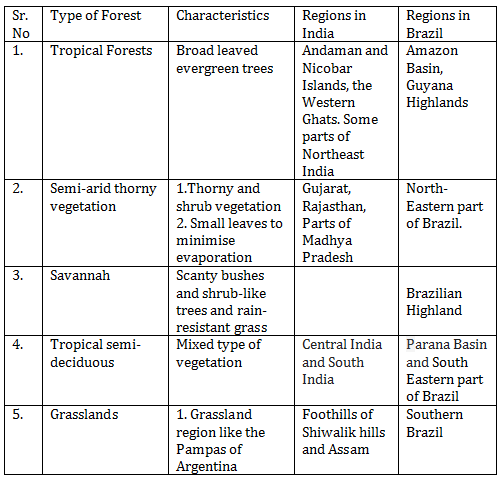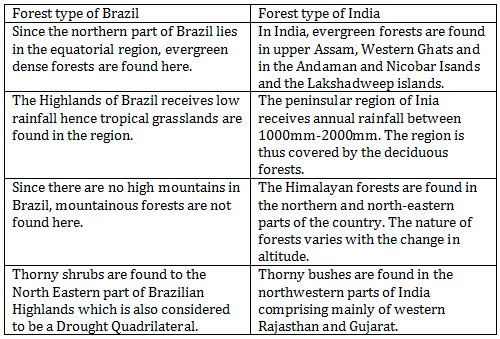Class 10 MAHARASHTRA STATE TEXTBOOK BUREAU Solutions Social Studies Chapter 5 - Natural Vegetation and Wildlife
Natural Vegetation and Wildlife Exercise 36
Solution 1

Solution 2 (1)
c. The Himalayan forests
Solution 2 (2)
b. Mediterranean forests
Solution 2 (3)
d. Lion
Solution 2 (4)
c. Orchid
Solution 3
a. Evergreen forests iii. Pau Brasil
b. Deciduous forests- v. Teak
c. Coastal Forests- i. Sundari trees
d. Himalayan forests- ii. Pine
e. Thorny and bush type vegetation- iv. Khejadi
Solution 4 (a)

Solution 4 (b)
- Since both India and Brazil have vast latitudinal extent, there is a diverse wildlife in these countries.
- The dense evergreen forests of India in the west, north east India and the Amazon Basin of Brazil are a home to a large variety of birds, insects, reptiles along with the herbivores and the carnivores. Animals that are found in the tropical evergreen forests are one horned rhinoceros in the forests of Assam and West Bengal, elephants, lemur, deer and monkey. Guinea pigs, crocodiles, alligators, monkeys, pumas and leopards are some of the animals that are found in Brazil.
- Grasslands of Brazil like the Savannah and the deciduous forest of India have a large number of herbivores and carnivores.
- The dry region in north easter parts of Brazil and in northwestern parts of India has thorny and scrub vegetation. The leaves are small and thorny to prevent the loss of water.
- Snow leopards and yak are found in the snow-capped regions of the Himalayas in India.
- India is the only country where both tigers and lions are found.
Solution 4 (c)
- The main environmental problem faced by Brazil is the degradation of land due to deforestation. The forests in Amazon basin are fast depleting.
- Slash and burn cultivation have also resulted in the deletion of forests area. The wildlife in Brazil is also under threat because of illegal smuggling of animals. It is because of these reasons that many endemic species are on the verge of extinction.
- In India, deforestation on a large scale have led to several environmental problems.
- Many species of wildlife in India are on the verge of extinction because of poaching, pollution, deforestation and illegal mining. 'Cheetahs', the fastest running land animals have already become extinct in the country.
Solution 4(d)
- Both in India and Brazil forests are being cut down to fulfil timber requirements of construction and furniture industry.
- Forests are also depleted because of the expansion of agriculture and cities due to growing population.
- In both countries forests are also cut down because of the rising demand of firewood.
- India and Brazil are developing countries and hence forests are being cut down for constructing dams, highways, laying railway lines etc.
Natural Vegetation and Wildlife Exercise 37
Solution 4 (e)
India lies in tropical and sub-tropical regions. Most parts of the country receive rainfall between 100-120cm. Deciduous forests thrive well in such climatic conditions. The trees shed their leaves during dry weather to conserve water.
Solution 5 (a)
The equator passes through northern Brazil. As the temperature is high, it rains all the year round. Thus, the northern part of Brazil is covered with dense vegetation.
Solution 5 (b)
The temperatures are freezingly cold in the higher altitudes of the Himalayas. The land is also covered in snow for most parts of the year. Hence vegetation is scarce in the high altitudes of Himalayas.
Solution 5 (c)
Insects are mostly found in forests, grasslands and swampy lands. The evergreen rainforests are found in the northern parts of Brazil. The central parts of Brazil have grasslands and Paraguay-Parana River basin. Similarly, swampy lands are found in Pantanal region in Brazil. Hence, a wide variety of insects are found in Brazil.
Solution 5 (d)
Forests are being cut down in India due to the expansion of cultivation and urbanization. Due to the shrinking of forest cover, the wildlife is decreasing. Also, poaching and hunting of animals have also led to the dwindling number of wild animals in the country.
Solution 5 (e)
Like India, Brazil is also facing the problem of environment degradation due to felling of trees in a large number. In the Amazon basin, trees are cut down for fulfilling timber requirements. Agricultural practices like slash and burn agriculture (roca) has reduced the forest cover in Brazil. Thus, Like India, there is need of conservation of forests in Brazil too.

